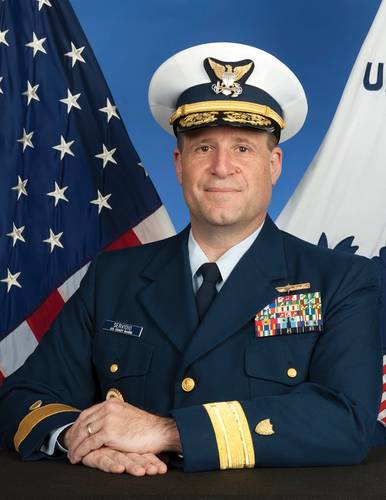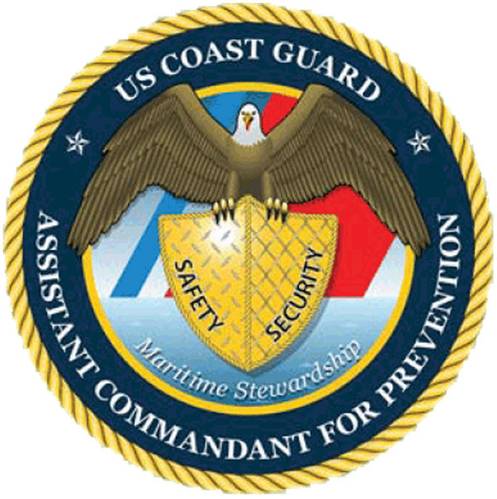Insights: Rear Admiral Joseph A. Servidio
Assistant Commandant for Prevention Policy United States Coast Guard
Rear Admiral Joseph A. Servidio is Assistant Commandant for Prevention Policy overseeing Inspections and Compliance, Marine Transportation Systems, and Commercial Regulations and Standards. Theses directorates include waterways management, navigation and boating safety, commercial vessels, ports and facilities, merchant mariner credentialing, vessel documentation, marine casualty investigation, inspections, and port state control. His previous assignments include numerous postings in marine inspection, marine safety and investigation billets. Servidio is a graduate of the U. S. Coast Guard Academy, earning a Bachelor of Science Degree in Ocean Engineering. He also earned two Masters of Science Degrees in Engineering and is a Licensed Professional Engineer. This month, follow along as the Coast Guard’s top prevention officer provides a frank situation report on the broad expanse of maritime regulations, marine safety and Coast Guard policy:
The Passenger Vessel Association (PVA) recently commended the Coast Guard’s Notice of Proposed Rulemaking on Transportation Worker Identification Credential (TWIC) Readers. While this sector might be happy, other sectors may not be satisfied with not getting similar consideration. What, if anything, sets this industry aside from others?
I expect that the PVA is referring to the exemption in the proposed rule for all vessels with 14 (I believe) or fewer crew members who are required to hold a TWIC. This provides relief from the reader requirements for most passenger vessels as well as for almost all barges, OSVs, and many other vessels. This proposed exemption recognizes that on vessels with small crews, a TWIC reader may not be required for the Vessel Security Office to verify the identity of the people he or she works with closely every day.
The Coast Guard has made a concerted effort in recent years to ramp up its marine inspection groups, both in terms of numbers and competence; recruiting more maritime academy people and merchant officers. How is that going?
We have made a concentrated effort to enhance capacity and competency of our Marine Inspectors and Investigators, and we’ve made great progress. Since 2009, we’ve added hundreds of people to our workforce, increased the number of civilian marine inspectors and investigators, established six National Centers of Expertise, and improved our training facilities and curriculum. We’ve also created 19 feeder ports around the nation where we train our apprentice Marine Inspectors, including many who come straight from maritime academies and a growing number who have previous experience in the maritime industry. Civilian personnel currently make up nearly 30% of our marine inspection and investigation workforce, and they provide expertise and continuity that we believe is critical in achieving the level of service required both today and in the future.
When the new Sub M rule does become official, will you have enough inspectors to do the work? More importantly, will they be qualified? Will you sub this out like TVE and COI work to class?
I recognize that Subchapter M will bring new workload to the Coast Guard, and could have resource implications for us. That said, we have added some positions in anticipation of the new regulations and have developed qualification standards and courses to train and orient our people. Our Towing Vessel National Center of Expertise in Paducah is another resource we use to train our people and the industry in preparation for Sub M. The industry and the Coast Guard have also learned a lot of lessons in implementing our “bridging program” to Sub M; both phases I (voluntary) and II (targeted) of the bridging program have gone very well. Additionally, we have the regulatory flexibility to ensure that our inspection program for towing vessels takes advantage of all options, including third parties (we don’t “sub out” work, and we don’t “sub out” TVEs and COIs). We see properly qualified, and properly overseen, third parties as an important part of Sub M, as was noted in the NPRM. I’m confident that smooth and successful implementation of Sub M will not be impeded by a shortage of Coast Guard resources.
As many as 20 percent of existing operators may go out of business or have to be absorbed by others as a result of trying to comply with SubM. Do you think the process will produce such draconian results?
Our goal is to provide a regulation that enhances the safety of towing vessels and safeguards the lives of those who work in this industry without creating an undue burden. I think the NPRM did a pretty good job of doing this, and the comments we received to the NPRM will make it better. For the most part, the feedback I get from the industry is favorable, and our careful review and evaluation of all of the comments made could result in adjustments that will alleviate some concerns people have noted. I think the flexibility built into the proposed rule, including the option to use Coast Guard or a third party to verify compliance, will help.
MLC (2006) is coming. You are producing your own operating rules and compliance requirements. Comments from industry have been coming in. What difficulties do you foresee in compliance and/or enforcement?
The U.S. has not ratified the Convention and may not do so by the entry into force in 20 August 2013. In the meantime, the Coast Guard is establishing a voluntary certification program for vessels in international voyages. The purpose of the Coast Guard’s voluntary certification program is to provide U.S. vessels the ability to demonstrate compliance with U.S. laws, regulations or other measures conforming to the requirements of the MLC, minimizing their risk for Port State Control actions, including detention. A draft Navigation and Vessel Inspection Circular (NVIC) was published in the Federal Register in February and the comment period closed in March. We received many comments and currently editing the NVIC to address these comments. We expect to publish the final NVIC in June.
The newly issued EPA VGP eliminates vessels below 79 feet for compliance with BWT rules, in so far as equipment is concerned. Is it consistent with what you envision the rule to be?
The Coast Guard’s ballast water management requirements apply to sea-going vessels previously required to conduct ballast water exchange, and coastwise vessels that do not operate outside the Exclusive Economic Zone (EEZ) but are greater than 1,600 gross register tons (GRT) and transit between Captain of the Port zones. More Coast Guard guidance is available at http://www.uscg.mil/environmental_standards/. EPA states in the 2013 VGP that it expects that most vessels seeking coverage under that permit will be greater than 79 feet in length. The EPA also notes that commercial vessels less than 79 feet are also eligible for coverage under the permit, or may seek coverage under EPA’s small Vessel General Permit (sVGP). The EPA also exempts inland and seagoing vessels less than 1600 Gross Registered Tons from the ballast water numeric discharge limits. For specific details on EPA’s Vessel General Permit program, interested parties should visit http://www.epa.gov/npdes/vessels or email [email protected].
Sequestration: will it affect regulatory enforcement metrics? What immediate impact will it have on the Coast Guard’s regulatory missions?
Our Commandant has said that people are our priority, and we will look to not furlough anyone. As such, I do not expect budget issues directly impacting any regulatory compliance and enforcement metrics, or delaying rulemaking efforts. However, the fiscal situation has adversely impacted our ability to travel, and affected some engagement with stakeholders. Although I believe we can successfully employ other engagement mechanisms, it is something we will monitor with respect to our compliance and/or rulemaking activities.
Congress is asking for an assessment of the National Maritime Center’s merchant mariner medical evaluation program? Are that many unsatisfied with the rule? How has it been going since the NVIC 04-08 was enforced?
Congress has a responsibility to oversee our Coast Guard activities, and we welcome their oversight of the Mariner Credentialing Program. We believe we have made very good progress with regard to medical evaluations, and are happy to report where we stand. The feedback I consistently get from the industry, from unions, and from mariners -- and I get a lot of feedback --indicates good and increasing satisfaction with the National Maritime Center and the medical evaluation program. Only about one half of one percent of mariner applications are denied due to medical unsuitability, and mariners’ understanding of our medical evaluation process has increased greatly. We have done a lot to improve our medical evaluation process, including growing the medical staff at the NMC and establishing the Merchant Mariner Medical Evaluation Advisory Committee (MEDMAC), a federal advisory committee consisting of medical doctors and mariners specifically tasked to advise the Coast Guard on the medical evaluation process. MEDMAC is currently reviewing and revising NVIC 04-08 with specific focus on the top ten medical conditions that currently disqualify mariners. MEDMAC is also developing recommendations to the Coast Guard on the development of designated medical examiner program, similar in concept to the program the FAA uses for medical evaluation of airplane pilots. The Coast Guard opted to seek public comment via the Federal Register in the course of developing our Report to Congress so that we can provide an accurate and reflective report. I welcome and encourage all of your readers to provide comments, particularly those related to the options for a designated medical examiner system.
A common complaint from within and outside the Coast Guard is that marine inspection and credentialing billets have not been good “career” tracks and the programs have not attracted the best and the brightest. Assuming this to be true – perhaps you don’t agree – where is the Coast Guard ensuring that credentialing and marine safety have equal footing with other traditional Coast Guard career paths?
As you correctly anticipated, I do not agree with your assertion. On the contrary there is wide spread recognition that the maritime industry is very dynamic, extremely challenging, technologically pushing barriers, and full of opportunity, and a Coast Guard career working with this industry is equally so. Increased opportunities for continuing education, advanced degrees, industry training and ship riding programs further enhance prevention careers. I am very fortunate to work with some of the Coast Guard’s best and brightest, and I can assure you that the Commandant and all of our Coast Guard leadership values our prevention professionals, and fully recognize and appreciate what they add to the Coast Guard and our nation.
Offshore deepwater U.S. Gulf: the effort to ramp up safety offshore is being driven on the rigs, platforms and by BSEE. These efforts do not necessarily address OSV’s. Describe anything you might be doing with that sector to increase safety?
We’ve been very focused on improving safety on the Outer Continental Shelf (OCS), working closely with the Bureau of Safety and Environmental Enforcement (BSSE) and the industry to address identified safety and environmental gaps, both those that may exist today and those that may be developing. I anticipate publishing the Large OSV rulemaking this year. This rule was mandated by Congress in the 2010 Coast Guard Authorization Act. This will provide for Offshore Supply Vessels (OSVs) greater than 6000 GT. In addition, we are working on revisions to Subchapter N – Outer Continental Shelf activities, and are considering other possible refinements to our existing regulatory structure. Also, we have been improving our CG Marine Inspector (MI) competency with regard to OSV inspections. While some of this work was started pre-Macondo, we have conducted an analysis of the skills that MI’s need to adequately perform inspections on OSV’s, which can be much more complex than that which I inspected two decades ago, integrating these needs into the MI training curriculum. Teaching MI’s about dynamic positioning systems, an example of a commonly used propulsion arrangement, will improve an MI’s ability to do an inspection. Updates to MI policy documents such as our Marine Safety Manual to address OSV issues are also underway. We have also worked toward getting better data on mishaps or potential casualties with regard to OSV DP operations. We have published requests for voluntarily reporting of DP incidents to help us better understand the risks associated with DP on OSVs, and hope industry recognizes the benefits increased awareness, and voluntary reporting now, could have on the future.
TWIC readers still appear to be the sticking point for real acceptance of the TWIC card by industry. A West Coast Terminal is now using a TWIC reader that they say works. How close are we to defining specifications and reaching the desired goals of the TWIC program?
TSA administers the process to evaluate and qualify TWIC readers through the “Qualified Technologies List (QTL)” process. Now that we have published the NPRM, manufacturers have a better understanding of the timing and scale of the market demand for readers. We expect manufacturers to begin submitting models for testing, and TSA held a public meeting that we attended on April 15th to explain the QTL process. For more information, see: http://www.tsa.gov/stakeholders/reader-qualified-technology-list-qtl. The TSA and the Coast Guard continue to work together to find ways to improve TWIC and TWIC readers security benefits and customer service, as well as lower costs.
(As published in the May 2013 edition of Marine News - www.marinelink.com)















